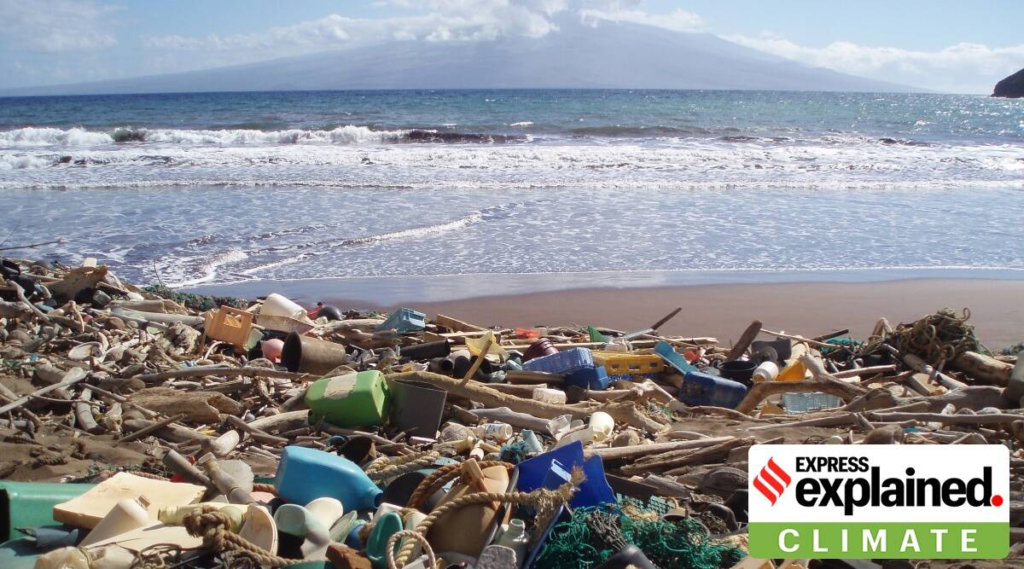An estimated 170 trillion plastic particles weighing about 2 million metric tons are currently afloat in the oceans across the world, according to a new study, which added that if no urgent action is taken then this number could nearly triple by 2040.
Published recently in the journal PLoS ONE, the peer-reviewed study, ‘A growing plastic smog, now estimated to be over 170 trillion plastic particles afloat in the world’s oceans — Urgent solutions required’, has been done by Lisa M Erdle and Marcus Eriksen of the 5 Gyres Institute (California), Win Cowger of Moore Institute for Plastic Pollution Research (California), Patricia Villarrubia-Gómez of Stockholm Resilience Centre (Sweden) and six other researchers.
“The situation is much worse than expected. In 2014, it was estimated that there were 5 trillion plastic particles in the ocean. Now, less than ten years later, we’re up at 170 trillion,” Villarrubia-Gómez said in a statement.
Speaking to The Indian Express, Cowger explained that although it’s difficult to point out the exact number, a vast majority of these plastic particles found on the ocean’s surface are microplastics — these are tiny plastic particles that measure less than 5mm in diameter.
Microplastics are particularly harmful to the oceans as they don’t readily break down into harmless molecules and adversely affect the health of marine organisms, which mistake plastic for food. Moreover, these particles can trigger loss of biodiversity and threaten ecosystem balance.
For their analysis, the researchers examined surface-level plastic pollution data from nearly 12,000 ocean stations in six major marine regions, from 1979 to 2019. Then they combined this with data they collected during their own expeditions. Finally, by using computer modelling, the researchers were able to come up with a global time series to estimate not only how much microplastic is currently in the oceans but also how their concentration has changed over the years.
They found that from 1990 to 2005, the number of plastic particles more or less fluctuated. One of the reasons for this could be due to the effective implementation of important policy measures at the time. “In the 1980s and 90s, there were some international policies, like MARPOL Annex 5 that enforced laws against dumping trash at sea. They were powerful laws that were enforceable and were preventative,” Erdle told The Indian Express.
However, things went downhill soon after as the world began producing much more plastic than ever before. “Since 2005 we have produced more than 5,000,000 tons of new plastic into the world, and with more plastic there is more pollution,” said Erdle, adding that the older rules weren’t enough to thwart the rising plastic pollution.
Therefore, as the study pointed out, the concentration of plastic particles including microplastics in the ocean has skyrocketed in the oceans since the mid-2000s, and it continues to increase. Researchers further mentioned that if the world fails to take any drastic action about the issue, there will be a 2.6-fold increase in plastic flowing into aquatic environments by 2040.
“So far this century the policies trying to address plastic pollution have been weak, and they have been voluntary and focused on recycling and cleanup. They just don’t work very effectively. That’s why in our paper we advocate for a strong UN treaty on plastic pollution that is enforceable, not voluntary, and preventative, not focused on Clean up and recycling.,” Erdle said.
Several recent studies have detected microplastics in marine organisms, from phytoplankton to whales and dolphins, which might prove hazardous for them. According to Eriksen, one of the co-authors of the new paper, the ingestion of such particles can cause “mechanical problems, such as lacerations and blockages to internal systems.”
He further added, “Ingested plastics can cause chemical problems by leaching absorb chemicals into organisms. We know that microplastics absorb many hydrophobic compounds, like DDT, PCBs and other industrial chemicals, and evidence shows they can be released when ingested.”
Not only this, but microplastics can also disrupt the carbon cycle of the oceans. Normally, phytoplankton absorbs carbon and are eaten by zooplankton, who excrete the carbon in the form of faecal pellets that sink to the sea floor. Once these carbon-containing pellets reach there, “the carbon can be remineralized into rocks — preventing it from escaping back into the atmosphere,” reported Grist magazine.
But if zooplanktons consume microplastics, their faecal pellets sink at a much slower rate, which means they are more likely to break apart or be eaten by other animals — “making it less likely that the carbon will reach the seafloor and become permanently sequestered”, the report added.
Researchers of the latest study suggested that there is an urgent need to implement a global resolution to limit the production of single-use, throwaway plastic.
“We need cities to be responsible for managing their waste so it does not leave their territory. We need to reduce the amount of chemical additives in new plastic products. If we talk about recycling, there have to be requirements that recycled plastic be used in new products. The industries that make plastic like to talk about how technically we can recycle all of it. But they don’t like to commit to buying recycled plastic, therefore recycling fails. They have to legally be required to put at least 75% recycled plastic in any new product,” Erdle said.
Gen (retd.) Bajwa put pressure on me to develop friendly ties with India, claims Imran Khan

Alind ChauhanThe write is a journalist at The Indian Express…. read more

